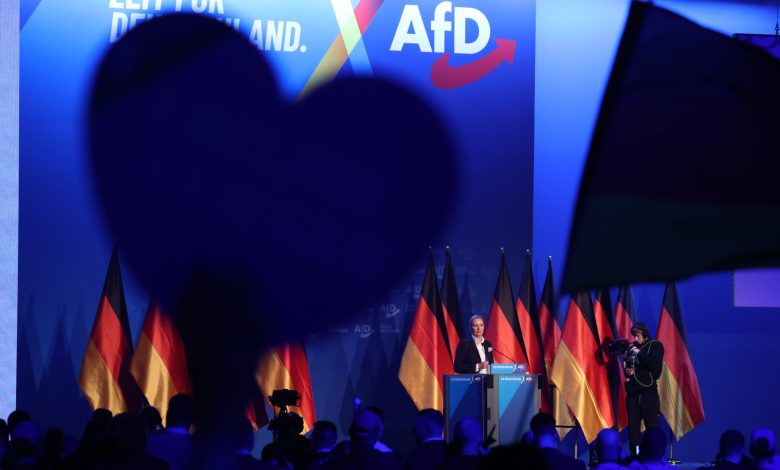East Germany is a far-right stronghold — economics helped make it happen

Alice Weidel, chancellor candidate of the far-right Alternative for Germany (AfD) political party, speaks to supporters as they wave German flags at the AfD election campaign launch rally.
Sean Gallup | Getty Images News | Getty Images
Germany’s far-right party is dominating polls in the country’s eastern region less than two weeks before the federal elections on Feb. 23 — and economic concerns have played a part in its popularity.
After the fall of the Berlin Wall in 1989, the economy in East Germany broadly collapsed as local businesses and companies faltered and unemployment soared. Despite the federal government spending hundreds of billions of euros boosting the region’s economy and developing its infrastructure, the turmoil has left a sour taste in the mouth of many from the region.
“Since the transformation of the 1990s, economic insecurity has been a regular sentiment among part of the eastern German population,” Manes Weisskircher, a political scientist at TU Dresden, told CNBC.
This has played into the hands of the Germany’s Alternative fuer Deutschland (AfD) and other fringe parties that historically tend to perform far better in East Germany.
Germans will cast two votes at next week’s polls: one for which candidate will directly represent their constituency, and one for a party.
The latest polling and modeling from YouGov of the constituency vote shows something of a right-wing blue wall in Germany’s east. In most eastern constituencies, AfD candidates are in the lead. This is not the case across the country, however.
The CDU, with its affiliate party the CSU, is leading national polls with around 30% of the vote, while the AfD is in second place with around 20%, reflecting growing support for the party across the country. The AfD clinched just over 10% of the vote in the last federal election.
It is unlikely to join the next ruling coalition, as mainstream parties have so far refused to partner with the AfD.
Economic perceptions vs. reality
After the German reunification following the fall of the Berlin Wall, the economy of East Germany was characterized by lower incomes, higher unemployment and weaker growth compared to the West.
These issues have since largely disappeared, and factors such as economic growth and unemployment are no longer major concerns, according to Holger Schmieding, chief economist at Berenberg.
Germany’s Ifo Institute for Economic Research is projecting 0.7% economic growth in East Germany this year, more than is expected for the country overall. Data from Germany’s federal employment agency shows that the unemployment rate in East Germany has more than halved from its highs, with the gap compared to unemployment in the West shrinking sharply.
In some ways, East German states are actually ahead of their Western counterparts, Schmieding said.
“Adjusted for cost of living, East German living standards are no longer substantially below those in the West. The infrastructure is usually newer and in better shape than in most parts of the West,” he told CNBC.
Nevertheless, residents in East Germany still have a negative perception of the economy, according to 2024 research conducted by the German Economic Institute (IW). Less than one third of East German respondents said they were satisfied with how the labor market has developed, and only one in five people said they believed they lived in a region with emerging growth.
Matthias Diermeier, head of the research unit for democracy, society and the market economy at IW, told CNBC that while AfD supporters are only slightly more concerned about their personal economic situation, compared to others, “their perception of the economy in general is much worse.”
The vast majority of AfD voters say they are strongly concerned about the wider economy, while those who endorse other parties are on the other end of this spectrum, Diermeier added.
AfD capitalizes on economic insecurity
Despite what IW refers to as a clear economic catch-up process, inequalities between East and West Germany remain, Diermeier noted.
“This is seen as unjust, unfair … by supporters of the fringe parties, but it’s also a sentiment that is very strongly activated by these political actors,” he explained, adding that the far right has worked to trigger pre-existing feelings of economic insecurity, being a “second class citizen,” and social decline among voters.
“And this is what they do very successfully,” Diermeier said.
At the same time, the AfD questions the accuracy of positive economic news, and — given the perception that the economy is not faring well — plays an “easy game” by claiming that mainstream parties, statistics agencies and other state-controlled bodies are misleading voters, he said.
The AfD did not respond to CNBC’s request for comment.
TU Dresden’s Weisskircher also noted that the historical context is a significant factor.
“Economics matters, rather because of a sentiment of long-term insecurity and unclear economic prospects — in a region that experienced severe economic problems in the 1990s and early 2000s, with high unemployment rates, among other issues,” he said.
Anti-immigration, anti-establishment, anti-climate change
It isn’t just economic concerns that have driven the success of the AfD in East Germany.
Opposition to immigration is much higher in East Germany, and mainstream parties have less of a loyal base in the region, where they were not as present prior to the national reunification, Weisskircher said.
Skepticism regarding climate change and green energy policies are also part of the AfD’s campaign. Wind turbines in particular have become a contested topic, with the AfD’s lead candidate Alice Weidel for the upcoming election calling for them to be torn down.
The AfD also positions itself as the party representing those who have been left behind.
A growing number of East Germans are leaving more rural regions in favor of major cities, Berenberg’s Schmieding explained, and this has weighed on local businesses, services and development. Those remaining in these areas are prime targets for the AfD’s rhetoric, and, as IW’s Diermeier noted, research has shown that these demographics are more prone to voting for the far right.



